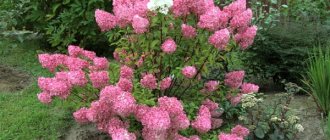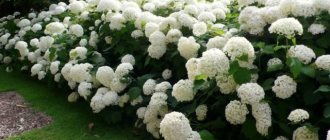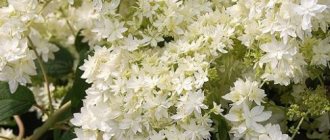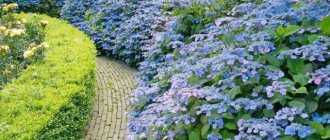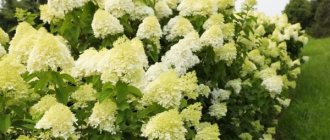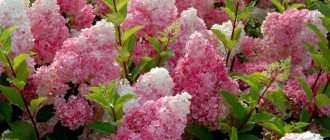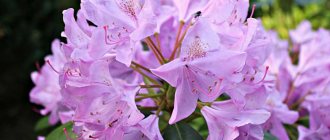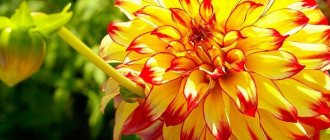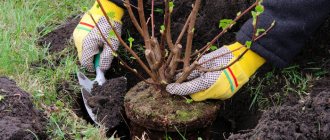History of selection
The hydrangea flower was first brought to Europe from China in the 18th century, and after 2 centuries the widespread popularization of this plant began. Soon, the variety of varieties and hybrid forms of hydrangea exceeded 100 varieties and subspecies, differing in height, bud size and degree of resistance to adverse weather conditions.
The Weems Red hydrangea variety was developed not so long ago. Its originator is the German breeder Wim Rutten. The main difference between the flower and others is the very early flowering time - the Weems Red hydrangea blooms earlier than all other types and varieties of hydrangeas.
Application in landscape design
The presentability of Angel Blanche hydrangea, which can be easily assessed from the description of the variety and photo, makes it possible to use it for solo plantings. The bushes tolerate pruning well, so you can turn them into a hedge and “adjust” their size and shape.
In any composition, Angel Blanche hydrangea will become the central accent. Decorative conifers are often used as “companions” for her. This combination is not only effective, but also useful. Coniferous plants acidify the soil, maintaining an optimal pH for hydrangea. You can supplement the composition with different varieties of hosta and bergenia.
A well-groomed lawn or hedge will be a worthy “backdrop” for Angel Blanche hydrangea.
Description of paniculata hydrangea Weems Red
Hydrangea paniculata Wim's Red is a dense, fairly compact deciduous shrub, characterized by long and abundant flowering, which lasts from July to September, and even until October in regions with warm climates.
The average height of adult plants is 1.5-2 m. The shoots of Weems Red hydrangea are moderately rigid and weakly branched. The skin on the shoots is brown-red. Under the weight of large inflorescences, some branches of the hydrangea can bend, due to which the appearance of the bush begins to resemble a ball.
The leaves of Hydrangea paniculata are dense, ovate, dark green with pronounced veins. On the shoots they are located opposite. The inflorescences externally resemble tall, elongated pyramids. The length of the inflorescences varies from 20 to 35 cm.
As they bloom, hydrangea buds change color: at first they are white, but soon acquire a pinkish tint. Then this color smoothly flows into a rich burgundy tone.
The aroma of the Weems Red variety is pleasant, of medium intensity. Many gardeners note in their reviews that it contains pronounced honey notes.
A flowering bush of Hydrangea paniculata variety Weems Red is shown in the photo below.
Winter hardiness of hydrangea Weems Red
The resistance of Weems Red hydrangea to low temperatures, according to the description of this variety, is quite high. The plant tolerates frosts down to -30°C without any negative consequences.
Resistance to diseases and pests
The plant's resistance to diseases is average. The greatest threat to Weems Red hydrangea is from the following diseases:
- chlorosis;
- powdery mildew;
- anthracnose
Plants can also be affected by the following pests:
- spider mite;
- aphid;
- Colorado beetle.
Methods for propagating hydrangea
Hydrangea paniculata varieties Weems Red are propagated in different ways. You can do this:
- seeds;
- layering;
- cuttings.
This flower is practically not propagated by seeds, since this method has many disadvantages. Hydrangea seeds have low germination, and growing full-fledged seedlings is time-consuming.
Cuttings for propagating hydrangeas are taken as annuals. Old shoots do not take root well. The algorithm for preparing cuttings is as follows:
- The bush is cut at the bottom, immediately after the bud. The total length of the cutting should be 15-18 cm and contain at least 3 internodes.
- Cut cuttings are immersed in water for 3 days.
- For better development of hydrangea, it is recommended to treat the lower cut of the cutting with any growth stimulant.
- After the specified time, the cuttings are planted in a container with a pre-prepared peat mixture. The cuts are deepened by 2/3 of the total length.
- After planting the cuttings, the soil is moistened daily.
- In spring, planting material is planted in open ground.
As a rule, preparation of cuttings begins in late June and is completed by autumn.
The procedure for propagation by layering includes the following steps:
- In spring or late summer, one of the lower shoots of the hydrangea is bent towards the ground and attached to the ground with a metal bracket.
- Then the place of contact with the soil is cut and slightly deepened. It is important that the end of the shoot is in a vertical position.
- Next year the cuttings should take root. Then it is carefully separated from the bush and moved to a new place.
With this method of propagation, hydrangea blooms the very next year after planting.
Growing conditions
The key requirements for growing this variety of ornamental plants are:
- soil quality and its chemical composition;
- humidity level;
- lighting characteristics.
Priming
"Weems Red" develops optimally when the soil is slightly acidic. Areas with a neutral acid-base balance are acceptable. However, it is impossible to get brightly colored flowers on them. Alkaline soil will completely destroy paniculate hydrangea. Therefore, it is absolutely forbidden to plant it where lime was placed.
In this case, high fertile soil qualities and the presence of a significant amount of organic matter are desirable. Hydrangeas do not develop well on sand. Their growth can slow down quite significantly. Brown peat or sawdust is used to acidify the soil. It is forbidden to add not only lime, but also ash and chalk to the soil.
Temperature and humidity
Panicle hydrangeas need partial shade. Direct sunlight should only fall on them in the early morning or evening hours. During the day, the bushes are covered with taller plants or buildings. In principle, you can grow this shrub in full shade. However, with a lack of lighting, flowering becomes unreasonably scarce.
Hydrangea needs moisture in large quantities. Sometimes even special watering is not enough. Therefore, it is advisable to plant this variety in humid places. Of course, the land should not be swampy - this is also bad. If in summer there is not enough naturally flowing water, additional irrigation is necessary.
Planting and caring for paniculate hydrangea Weems Red
According to the description of the Weems Red hydrangea variety, planting and subsequent care of the flower will not be difficult. If the planting dates and site requirements for planting are met, there will be no problems with growing these flowers.
Recommended timing
Hydrangea of this variety can be planted both in autumn and spring. Each time has its advantages depending on the planting region.
In the Northern regions, when planted in spring, the chances of the plant to take root are somewhat higher than when planted in the fall. In temperate and warm climates, it is better to plant hydrangea in the fall, since after hardening by the winter cold, the plants develop more actively in the spring.
The soil for flowers is prepared in advance. 15-20 days before planting the seedlings, the area is dug up and fertilized with a mixture of peat, sand, leaves and turf soil.
Choosing a suitable location
Hydrangea paniculata develops best in conditions of high humidity, since its root system is not sufficiently developed and cannot independently take moisture from the lower layers of the soil. That is why it is better to give preference to shaded areas, although with frequent watering the flower grows well in the sun.
It is also important to provide flowers with protection from strong winds. It is better to plant bushes in areas provided with reliable barriers on the north side.
Despite the fact that hydrangea is considered an unpretentious plant, for the best development of the flower it is recommended to pay attention to the type of soil of the potential planting site. They usually focus on loose fertile soils with neutral or high acidity.
Important! Depending on the acidity level of the soil, the color of hydrangea buds varies greatly. Rich colors can be obtained by growing flowers in acidic soils.
This variety should absolutely not be planted on sandy soils or soils with a high lime content. However, if necessary, the acidity of the soil can be adjusted: to do this, the area is dug up and fertilized with fresh manure or sulfur sulfate. You can also use colloidal sulfur.
Selection and preparation of planting material
When choosing seeds for planting directly into the ground, you should pay attention to the age of the planting material. Old seeds have poor germination.
When choosing seedlings, the recommendations are the same as for many other garden crops. There should be no stains or plaques on the surface of the plants, as well as mechanical damage, since small wounds can easily infect the crop with a fungus or other infection.
Landing algorithm
Planting hydrangea varieties Weems Red is carried out according to the following plan:
- In the prepared area, planting holes are dug 40 cm deep. The diameter of the holes is at least 50 cm. The recommended distance between two adjacent holes is 90-100 cm.
- The fertile top layer of soil from the site is poured into the bottom of the planting hole. The layer thickness should be about 10-12 cm.
- In the center of the hole, a small hill resembling a hill is formed from this earth.
- The seedling is lowered onto this hill so that its roots are evenly distributed over the surface of the fertile soil. After deepening the plant, the root collar should remain above ground level.
- After the seedling is covered with soil, the soil is lightly compacted.
- Planting is completed with abundant watering.
Advice! For better moisture retention, you can mulch the flower’s trunk circle with straw or peat.
Additionally, the process of planting hydrangeas is described in the following video:
Growing conditions
Hydrangea paniculata “Diamond Rouge” is a rather unpretentious variety and does not require special conditions. However, factors such as lighting, humidity and soil composition still need to be taken into account.
Lighting
The Diamond Rouge variety does not tolerate direct ultraviolet rays and needs light shading. In the hot sun, the growth of the bush slows down and the inflorescences become smaller. In addition, under direct exposure to the sun, flowers fade and leaves get burned.
The best option would be to plant hydrangeas in partial shade, which is created by other plants. If this is not possible, or the plants intended to shade the hydrangea are still too small, you can erect a temporary protective screen that will protect young bushes not only from the destructive effects of ultraviolet radiation, but also from strong side winds.
Temperature and humidity
Hydrangea "Diamond Rouge" is quite thermophilic, but can also grow in cold climates. The optimal temperature for a flower is 15-25 degrees, however, if protected from direct sunlight, the plant tolerates higher temperatures well. In this case, the main thing is to ensure that the soil around the trunk remains moist. This requirement is due to the fact that the flower does not tolerate drought well and belongs to the category of moisture-loving species.
In this regard, “Diamond Rouge” is not recommended to be planted next to similar water lovers, in order to avoid competition. It is better to place the flower under the crown of ground cover species, such as saxifrage. However, despite its moisture-loving nature, Diamond Rouge cannot be planted in an area with close groundwater. An excess supply of moisture in the roots negatively affects the wintering of the plant, since roots that are too “wet” are more likely to die from frost.
Priming
The Diamond Rouge variety prefers clay/loamy fertile soils and practically does not grow in sandy substrates. This is explained by the fact that nutritional components are very quickly washed out of the sand, due to the deficiency of which the plant begins to starve. The best option for a flower would be loose, organic-rich soil with an acidity of 5.5 pH. Growing on acidic soils has a positive effect on the brightness of the inflorescences, which is why experienced gardeners recommend adding whey to the soil.
Getting into the soil, the bacteria in it create an environment favorable for hydrangea. In addition to whey, sawdust, half-ripe pine needles and brown peat contribute to soil acidification. They are added to calcareous and alkaline soils, after which they become suitable for planting Diamond Rouge. In a neutral environment, the plant, of course, will not die and will even bloom, but the inflorescences will be very pale and lose their attractiveness.
Caring for Weems Red hydrangea
Hydrangea Weems Red is quite resistant to most diseases and tolerates low temperatures well. If we add to this the undemanding nature of the light level, then caring for the flower comes down to only regular watering (since the plant is moisture-loving), optional fertilizing and pruning.
Watering
The frequency of watering depends on the prevailing weather. During frequent rains, plants are practically not watered. On hot days, the norm is up to 30 buckets of water per 1 m2. The top layer of soil near the bush should always be slightly moist.
Important! To water Hydrangea paniculata variety Weems Red, use only settled water.
Top dressing
The plantings are fed with potassium or ammonium sulfate, but only until mid-July. In August, superphosphate is already used.
The Weems Red variety also responds well to fertilizing with organic fertilizers. Whey, which acidifies the soil, has proven itself especially well. This fertilizing promotes abundant flowering and growth of green mass.
Mulching and loosening the soil
Immediately after planting, it is necessary to shallowly loosen the flower’s trunk circle and mulch it with sawdust. This is necessary in order to create a moderately humid microclimate near the root system of the plant.
Trimming
Weems Red hydrangeas are pruned annually, however, young plants do not require this procedure. The shoots begin to be pruned when the bush is three years old. This is necessary in order to improve flowering and rejuvenate the plant as a whole.
Pruning is done in March, before the first buds appear, or in the fall, when the bushes have completely shed their foliage. Cut cuttings take root well in the soil, so cut shoots are often used for flower propagation.
Preparing for winter
Preparatory procedures for wintering come down to sanitary pruning of paniculata hydrangea. It involves removing dry and broken shoots, as well as cutting off dried inflorescences. This is done because in winter snow may accumulate on them, which will result in the branches breaking under the weight of precipitation.
Sheltering shrubs for the winter
Adult plants in central Russia do not need to be covered for the winter - paniculate hydrangea is a frost-resistant garden crop. With the onset of cold weather, it is recommended to cover young seedlings and flowers grown in the Northern regions with foliage, burlap or spruce branches.
Diseases and pests, methods of control and prevention
Most often, hydrangea paniculata variety Weems Red suffers from chlorosis. Prevention of the disease consists of feeding plants with a solution of salts with a high iron content. Watering frequency – once every 15 days. If the flowers are still sick, then they need to be fed with iron chelate, after which the paniculata hydrangea will quickly recover.
Any fungicide can be used against fungal diseases. The insecticide "Aktara" effectively controls pests.
Diseases and pests
"Wims Red" is moderately resistant to pathological conditions. Particular risk is associated with:
- powdery mildew;
- chlorosis;
- anthracnose.
Among these diseases, chlorosis is predominantly found. Feeding plants with iron salts helps prevent it. The procedure is carried out 2 times a month. If the hydrangea does get sick, iron chelate will provide effective help. In the fight against pathological fungi, only branded insecticides that are suitable for the spectrum of action are used; home remedies are ineffective. Any pests that are dangerous to “Wims Red” are perfectly eliminated by the drug “Aktara”.
Against powdery mildew and leaf spot you need:
- "Skor";
- "Maksim";
- "Horus";
- "Quadris";
- "Ridomil Gold".
Some diseases begin due to improper maintenance and poor living conditions. The same chlorosis is provoked by iron deficiency or excess lime in the soil. Moreover, the simultaneous action of such factors enhances their negative effect. Signs of chlorosis are:
- yellowing of foliage;
- their gradual drying;
- preservation of the green color of the veins.
Chlorosis can cover the entire leaf or cause large spots to form on it. Both of these manifestations are equally dangerous and deserve immediate action. If you have no idea what exactly caused the disease, you need to adjust the acid-base balance of the earth. In addition to acidification with peat, it can be improved with Al2 (SO4) 3. The amount of reagents is determined by the level of soil alkalization and can range from 2 to 5 kg per 1 m2.
Irrigation with rainwater or the use of softeners helps prevent chlorosis. Instead, sometimes they use water to settle for several days. If these measures do not help, it is urgent to reduce the introduction of mineral fertilizers. Be sure to check their composition to exclude the appearance of unwanted components. At home, a solution is used to fertilize with iron: 2 g of vitriol per 1 liter of water.
If you need to use more or less vitriol, the amount of liquid is recalculated accordingly. Softening the solution is achieved by adding citric acid.
Important: if the bush is in a neglected state, you should give preference to the store-bought composition.
Hydrangea can get burned from strong sunlight. Sore spots become thinner and may even dry out. The only treatment is to shade the problem crop.
The combination of excessively bright light and lack of water leads to blackening of the foliage. Sometimes the disease begins with the appearance of a brown border. Lack of attention to the problem results in its aggravation - of course, this condition does not go away. The main treatment measure is shading the flower and watering it with the softest water possible. Then, over time, the situation returns to normal.
If the leaves not only turn black, but also curl and become limp, then the cause may be a serious temperature change and/or insufficient irrigation. When the foliage simply curls, but does not turn black or weaken, the cause can be sought in the presence of herbicides. When a white coating appears on a bush, it is better to remove diseased specimens immediately. It is impossible to cure them. But there is a high risk of infecting other plants.
Gray rot primarily attacks foliage and soft tissues that have not yet had time to strengthen. Excessive watering and unjustified crowding of plants contribute to its appearance. The infection manifests itself in the formation of softened gray areas on the leaves. It is recommended to cut out and burn all sore spots. Severely affected bushes should be destroyed immediately.
With weak development of gray rot, it is suppressed with Bordeaux mixture or the drug “Fundazol”. Downy mildew (aka white rot) is treated by removing the affected areas. Then the sections are disinfected with potassium permanganate. Protective drugs include potassium permanganate, Optima and Kuproksat.
Septoria disease develops when the weather is damp and cool in the summer. The fungus spreads from the base of the bush to the top. The spots have a diameter of 0.5 cm. Cut areas are disinfected not only with potassium permanganate, but also with garden varnish. Of the synthetic drugs, “Profit” helps.
